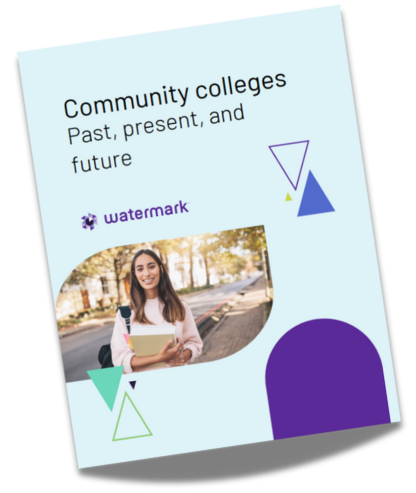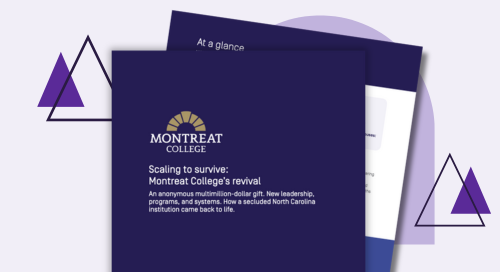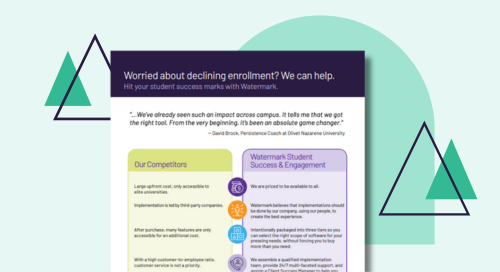Community colleges: Past, present, and future
Among all sectors of higher education in the United States, community colleges may be the one most closely linked to the American dream. The idea that anyone, regardless of their circumstances, can transform the opportunities available to them through industry and education, is not without its critics.
But this enduring optimism remains a driving force in two-year, degree-granting institutions, where nearly half of students rely on financial aid and where over half of the US’s most financially disadvantaged students will begin postsecondary education.
Community colleges can offer students of all ages, backgrounds, and life experiences a unique opportunity to succeed in today’s workforce through an education they may not have otherwise been able to access. But as higher ed undergoes rapid shifts, will this vital institution be able to adapt? In this eBook, we’ll explore the legacy of community colleges, how these institutions are operating today, and ways we may see them evolve in the future.
Save this eBook for later
Download now

The roots of community colleges stretch back to the early 20th century, when societal changes like industrial expansion, delayed entry into the workforce, and a push for educational access prompted the need for a new kind of institution. From the beginning, these schools were designed to serve the needs of their local communities. As industrialization shaped the American economy, community colleges became a hub for workforce development, adult education, and vocational training.
Today, many community colleges remain key economic engines for their regions. They may offer GED preparation, continuing education for adults, and certificate programs targeted at in-demand careers. In rural areas especially, these colleges can be the primary source for training healthcare workers, first responders, and technicians. Customized workforce programs allow institutions to respond quickly when new industries enter a region, offering training tailored to specific employer needs. “Local property tax is one of our big funding sources, so we have to be very aware of our community needs,” notes Becky Burton, MEd, Associate Vice President of Academic Learning at Amarillo College. “We probably supply 70 to 80 percent of the nurses in the region and 90 to 95 percent of all the rest of the healthcare professions.”
Community colleges have also long served students who face barriers to accessing four-year universities. Whether due to caregiving responsibilities, financial constraints, or academic underpreparedness, many students find two-year colleges to be the most feasible option. These institutions are designed to offer flexibility — both in terms of cost and scheduling — while still maintaining pathways to career mobility and further education.
Even as community colleges serve an essential role, they face chronic challenges that threaten their sustainability and effectiveness.
Funding remains one of the most significant hurdles. Unlike four-year institutions, which often benefit from larger state appropriations and private endowments, community colleges frequently operate on tighter budgets. They rely heavily on tuition, local taxes, and, increasingly, performance based funding models that reward metrics like completion rates — often without accounting for the unique demographics they serve.
Recruiting and retaining faculty can also be difficult, especially in high-demand fields like healthcare and technology, where industry pay often outpaces academic salaries. Rural colleges may face additional pressure due to population decline and fewer qualified applicants.
And for students, time is often the most precious — and scarce — resource. Many juggle full-time jobs, caregiving responsibilities, and coursework, making persistence and completion difficult. According to a Community College Research Center (CCRC) analysis of 2019–2020 federal data, nearly 75 percent of public two-year college students work while enrolled, and nearly half work full time.
Technology has become both a challenge and a potential equalizer for community colleges. The shift to virtual learning during the COVID-19 pandemic laid bare the digital divide. Many students lacked the computers, broadband access, or quiet spaces necessary for online coursework. This inequity continues to shape how community colleges deliver instruction. While some institutions have expanded laptop loaner programs and campus Wi-Fi hotspots, gaps persist, particularly in rural and low-income communities.
At the same time, technology has opened up new ways of serving students. Hybrid, asynchronous, and competency-based courses allow for greater flexibility. Remote access to advising, financial aid counseling, and tutoring helps institutions reach students who may not be able to visit campus during standard business hours.
Data tools are also playing a growing role. Predictive analytics and student success platforms allow advisors and coaches to flag at-risk students early and offer timely interventions. Instructors can see attendance patterns, assignment submissions, and course progress in real time, making it easier to support students before they disengage.
“We make a lot of things happen with a very small budget, and technology helps us do that,” says Chris Pearce, EdD, Vice President of Institutional Research and Technology at Vance-Granville Community College. “Because we don’t have the workforce to track all of our students and be there one-on-one with them as much as we would like, technology helps us track them and provide just-in-time interventions when they’re needed.”
For hands-on programs like welding, nursing, and phlebotomy, virtual simulation environments and AI assisted training have become valuable teaching aids. Virtual reality and augmented reality platforms allow students to practice procedures safely and repeatedly. These tools are especially helpful in environments where space, time, or equipment is limited. “Technology helps us out there as well,” says Pearce. “We can provide simulated environments to train students, so they don’t have to worry too much about hurting someone else or hurting themselves.”
As the workforce continues to evolve, the demand for short-term, stackable credentials is likely to grow. Employers increasingly value skills over degrees, and community colleges are well-positioned to offer quick-turnaround programs that help workers reskill or upskill in response to shifting job requirements.
Artificial intelligence is, of course, further changing the game. As automation affects industries from manufacturing to accounting, employees will need to pick up complementary skills that enhance human judgment, creativity, and empathy — qualities that machines, as of yet, cannot replicate. Community colleges can play a central role in delivering this type of incremental, career-aligned education.
Partnerships with K-12 schools will also be critical. Dual credit and early college programs can reduce time-to-degree and tuition costs, while introducing students to the idea of postsecondary education earlier. “Things like that are really the future for our students — getting them into college while they’re still in high school,” says Pamela Madden, MEd, Director of Academic Technology Applications at Amarillo College. “But we’ve got to get into K-12 sooner, because right now we aren’t getting to the students until they’re going into ninth grade.” By then, it may be too late to instill some of the most important soft skills — like problem-solving, teamwork, self-awareness and management, and social responsibility — that students will need in order to succeed as they further their education. And there are more barriers: College readiness tests, transportation, and limited financial aid options often prevent low-income students from participating fully in these programs.
As demographics shift and birth rates decline, some institutions, particularly in rural areas, may see enrollment drop. Federal grants and public investments will remain critical, though their availability is often contingent on political winds. That makes long-term planning difficult — and it makes the need for adaptable models even more urgent.
In 2023, House Bill 8 in Texas introduced a new outcomes-based funding model that rewards colleges for awarding credentials of value, completing dual credit milestones, and transferring students to four year universities. “That’s helpful in Texas, but nationally, I think funding is always still an issue for community colleges,” notes Burton. “We don’t get as large of a piece of the pie from the state as four-year institutions do, so we have to rely on performance funding, local taxes, and tuition and fees.“
Collaboration between educational sectors will be key to ensuring that students can move seamlessly between . Dual enrollment programs that allow high school students to take college-level courses can serve as powerful on-ramps, particularly when they’re aligned with workforce pathways.
Stronger transfer agreements are also needed. Many students who begin at community colleges never complete a bachelor’s degree — not because of a lack of ambition or ability, but due to credit transfer issues, opaque admissions processes, or limited advising. Creating clearer, more collaborative partnerships between two-year and four-year institutions can help bridge that gap.
There’s also an opportunity to better identify which students would benefit from what type of institution. Some learners thrive in smaller classes with hands-on instruction and support services; others need the research opportunities and academic focus of a four-year university. A more integrated system could help students navigate those options without unnecessary detours or delays.
The future of community colleges hinges on their ability to create new models — not just once, but continuously. “We can’t stay where we are. We can’t be happy with the status quo,” says Burton. “Always be willing to embrace change, to be rapid-cycle innovators.” Rapid-cycle innovation — where programs are assessed, adjusted, and relaunched in tight feedback loops — can help institutions stay responsive to the needs of both students and employers.
Technology partners will also play a growing role in helping institutions meet student expectations. From mobile-friendly portals to AI-enabled chatbots and streamlined financial aid platforms, these tools reduce friction and improve the student experience. Modern student information systems can now integrate platforms like Blackboard, Colleague, and CRM tools to give staff a holistic view of each student. Advisors and faculty can collaborate across departments, using real-time data to support academic and nonacademic needs.
Finally, investments in continuing education and non-credit programs are crucial. These offerings help workers transition into new fields, respond to emerging industries, and fill immediate talent gaps in local economies. However, they often receive less funding and attention than degree programs. A shift in policy and perception could unlock their full potential.
Innovation isn’t just about tech — it’s about mindset. Community colleges are often nimble by necessity. Many are already running pilot programs, redesigning courses for accelerated formats, and testing new models of instruction. This is exactly the kind of energy they should be bringing into the future.
Community colleges remain one of the most accessible and adaptable parts of the higher education system. Their impact extends far beyond graduation rates and economic development — they provide opportunity, stability, and transformation for students who might otherwise be left out.
As they navigate funding constraints, shifting demographics, and rapid technological change, their success will depend on strategic collaboration, smart innovation, and a continued commitment to the communities they serve.
The question isn’t whether community colleges have a future. It’s how they’ll choose to shape it.
Ready to position your community college for continued success? Learn more about Watermark.

Browse our resource library
See how our tools are helping clients right now, get in-depth information on topics that matter, and stay up-to-date on trends in higher ed







